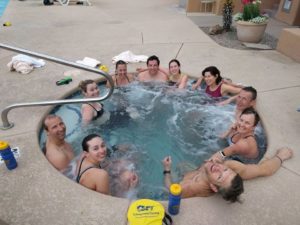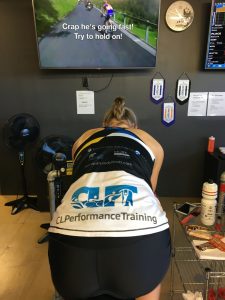For reasons of pride and practicality, nobody wants to show up at a training camp unprepared.
The prospect of getting outside again in the sunshine to train in warmer weather draws a lot of athletes to early spring training camps. Who doesn’t want to take a break from the pre-dawn swim sessions and hours on the trainer to get a head start on your season – especially with a group of other athletes? But showing up unprepared, and hoping to launch your training for the season there can really backfire. The last thing you want is to be bailed out mid-workout and hold the rest of your group back, or sit out because of an injury that will take several more weeks to rehab.
Here are some tips to make sure you arrive prepared to make the most of the opportunity.
- If you haven’t done any strength training…start now! Your heart and lungs might be able to handle going from shorter workouts to longer sessions and recover fairly quickly, but weak muscles can, and do, lead to injury. If nothing else, get in some core, glute and upper body strength sessions each day to start strengthening the muscles that will be required to get you through ramping up your workouts several days in a row.

- If you haven’t been in the pool since your last race…get back at it. Many triathletes struggle with the swim, and will take a run in the snow any day over lane swims. Chances are you need to re-establish your technique in order to start building endurance. Good technique requires using some of those muscles that are specific to the swim, which takes us back to point number one.
- Consider getting your bike fit or set up adjusted. Has anything changed since last season that needs some attention? Whether it’s optimizing new parts, or addressing a chronic injury, the bike set up is an important consideration. And as we progress – or regress – as athletes, our position on the bike changes. Make those adjustments now so you’re starting with an optimal set up for your season and the distance of your ‘A’ race/s.

- Deal with those aches and pains before they become injuries. Stretching, rolling and soft tissue work can make a huge difference in preventing the little things from becoming big things when volume and intensity ramps up suddenly. Even if you’ve been working your training program and have green patches all over your Training Peaks chart, sudden intensity can cause unexpected setbacks.
- Start cleaning up your diet. Extra pounds in winter tend to come off simply by getting outside and being more active in the daylight of summer. That’s tougher to manage when comfort foods are helping you get through the darker, colder days. Do yourself a favour and work at eating clean in the weeks leading up to your training camp. You’ll feel more energized and grateful when you aren’t hauling extra pounds up those long climbs!

- Stay hydrated. Athletes are fully aware of the benefits of being fully hydrated, yet many still have to force themselves to drink enough fluids regularly. Running in the cold weather can deceive us into thinking we don’t need as much fluid replacement, but we are still sweating and losing fluid with every exhale. Living and working in heated environments, choosing coffee too often, then travelling can compound and amplify the effect of arriving at training camp dehydrated, starting off at a deficit that can be hard to overcome. Don’t wait until you are filling water bottles for the first bike ride to think about your fluids.
- Pay attention to your sleep habits. If you’ve fallen into a routine of working out later in the day, you may find kicking into gear for an early morning start at training camp is a shock. Especially if late nights have become normal. This is a good time to start adjusting your body clock for an early start so you can get the most from your training camp experience.



